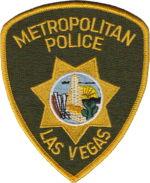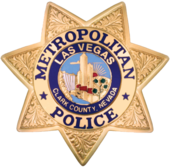Las Vegas Metropolitan Police Department
| Las Vegas Metropolitan Police Department | |
|---|---|
 Las Vegas Metropolitan Police Department patch | |
 Las Vegas Metropolitan Police Department badge | |
| Common name | Metro · Metro PD |
| Abbreviation | LVMPD |
| Motto | "Partners with the community" |
| Agency overview | |
| Formed | July 1, 1973 |
| Preceding agencies |
|
| Employees | 5,819 (2018) |
| Annual budget | US$856,312,417 (2018) |
| Jurisdictional structure | |
| Operations jurisdiction | Clark County, Nevada, US |
| Size | 8,061 sq mi (20,878 km²) |
| Population | 2,676,087(2024) |
| Legal jurisdiction | Clark County, Nevada, US (excluding the cities of Henderson, North Las Vegas, Boulder City and Mesquite) |
| Operational structure | |
| Headquarters | 400 South Martin Luther King Jr. Boulevard Las Vegas, Nevada |
| Sworn members | 4,109 (2022) |
| LVMPD Executive Staffs responsible |
|
| Area Commands | 10 |
| Facilities | |
| Airbases | 1 |
| Detention Centers | 3 |
| Marked and Unmarked Cars | c. 2,000 |
| Motorcycles | c. 160 |
| Boats | 3 |
| Helicopters | 5 |
| Dogs | 42 |
| Website | |
| lvmpd | |
| [1][2] | |
The Las Vegas Metropolitan Police Department (also known as the LVMPD or Metro) is a combined city and county law enforcement agency for the City of Las Vegas and Clark County, Nevada, United States. It is headed by the Sheriff of Clark County, who is publicly elected every four years. The sheriff is the only elected head law enforcement officer within the county, and, as such, the department is not under the direct control of its jurisdictional cities, Clark County, or the State of Nevada.
Metro is the largest law enforcement agency in Nevada, and in 2009, was one of the largest police agencies in the United States according to Uniform Crime Reporting by the Federal Bureau of Investigation.[3] The Clark County Detention Center is one of the largest jail systems in the United States, as well.
History
[edit]The Las Vegas Metropolitan Police Department (LVMPD) was formed on July 1, 1973, by merging the Las Vegas Police Department with the Clark County Sheriff's Department. Metro serves the city limits of Las Vegas and the unincorporated areas and towns of Clark County.
In the early 1970s, both the Las Vegas Police Department and the Clark County Sheriff's Department struggled with jurisdictional and budgetary problems. Oftentimes, people living in the metropolitan area would call the wrong agency to report crimes in progress, which would delay police response. Both agencies were also strapped for manpower, yet used a lot of it duplicating record-keeping and administrative functions in both of the agencies. The idea of consolidating the two law enforcement agencies into one metropolitan department began to circulate among the top officials in both agencies, likely due to the close working relationship between the Clark County Sheriff and the Las Vegas Police Chief at that time. It was said that even police officers on the Las Vegas Police Department could see that it would be better if the agency were run by the Sheriff, due to the fact that he was an elected official. Legislation to merge the Las Vegas Police Department with the Clark County Sheriff's Department was passed by the Nevada State Legislature, and the merger became effective in 1973.[4]
In 1999, an outside audit conducted by DMG-Maximus, commended the department for having fewer managers and supervisors than are typically found in large police agencies. The audit also said that the managers, both sworn and civilian, were of "excellent quality".[5]
On January 5, 2015, the Las Vegas Metropolitan Police Department officially assumed responsibility for the Las Vegas Township Constable's Office.[6] Las Vegas Township Constable's Office continues to be a separate entity but under Metro's Detention Services Division.[7]
The Las Vegas Metro Police Department has more than 5,800 members. Of these, over 2,900 are police officers of various ranks and over 750 are corrections officers of various ranks.[citation needed]
In November 2024, venture capitalist Ben Horowitz was reported to have funded at least $7.6 million in LVMPD purchases during the previous few years, and to have acted as facilitator between the department and at least six of his a16z portfolio companies. Purchases from Horowitz's donations include Skydio drones,[8] in which he was an early investor.[9]
Misconduct
[edit]Since the late 1970s, more than 100 LVMPD officers and civilian employees have been implicated in documented instances of police misconduct and/or actual criminal activity, with numerous incidents resulting in lawsuit settlements in excess of a million dollars apiece. A later excessive force case was tried in Davis v. City of Las Vegas. According to the New Yorker, the LVMPD had "a long-standing reputation as one of the most violent in the country" before it implemented reforms, in conjunction with the U.S. Department of Justice, in the 2010s.[10]
Radio system
[edit]LVMPD operated on a digital radio system (DesertSky), which was turned on in 2011. As of February 2018, the Las Vegas Metropolitan Police Department encrypted their radio frequencies; blocking the public from using police scanners, with no delayed web feed provided. The Las Vegas Metropolitan Police Department stated that the decision to encrypt their radio channels was made back in 2015 due to officer safety concerns.[11]
Vehicle fleet
[edit]
Las Vegas Metro uses many vehicles from brands including Ford, Hyundai, Nissan, Jeep, Buick, and Chevrolet as marked or unmarked vehicles. However, after the retirement of the Ford Crown Victoria in 2011, the Las Vegas Metropolitan Police went through a short session of testing vehicles. As a result, the Ford Explorer took the place of the Crown Victoria, the main patrol vehicle.

Headquarters
[edit]Construction was completed on LVMPD's 370,500-square-foot headquarters, located at 400 S. Martin L. King Boulevard, in mid 2011. The building consolidated 27 bureaus, which were previously located in leased buildings around Las Vegas. It also houses the Southern Nevada Counter Terrorism Center, Police Records, and a Fingerprint Bureau annex.
Funding
[edit]The police services of the department are funded by both the City of Las Vegas and Clark County. Police services funding is based on a complex formula that includes population, calls for service, and felony crimes in the prior year. Both entities must approve the annual budget, including the percentage of budget they are responsible for. The department itself generates approximately 33% of its funds through property tax, and the charging for certain services, such as special events, work cards, and privileged license investigations. Additional funding is generated from a special sales tax to fund commissioned positions.
By state law, the sheriff is charged with running the county jail, known as the Clark County Detention Center or CCDC, which is funded solely by the government and tax base of Clark County. Additionally, the police functions at Harry Reid International Airport are also solely funded by Clark County.
Organization
[edit]There are two commissioned career tracks in the LVMPD. They have identical civil service rank structures and pay, but different day-to-day tasks and responsibilities.
- Corrections: These officers are tasked with operating, managing and supervising the Clark County Detention Center; there are over 750.
- Police: These officers are assigned all over the department; there are over 2,900.
The LVMPD is divided into ten urban area commands:
- Bolden (Sectors U and W)—serves the west central portion of the city, including the old westside, an area bordered by I-15, US 95, Jones and Lake Mead Boulevards.
- Convention Center (Sector M)—serves the Las Vegas Strip and Las Vegas Convention Center areas.
- Downtown (Sectors A, B and C)—this division serves Downtown Las Vegas and areas roughly east of Eastern Avenue, south of Owens Avenue and north of Sahara Avenue to include the Naked City and Fremont Street areas.
- Northeast (Sectors F and G)—Sector F includes unincorporated areas of North Las Vegas and the Las Vegas Speedway/Nellis Air Force Base area.
- Northwest (Sector X)—serves areas generally west of US 95 and north of Cheyenne Avenue.
- Southeast (Sectors H, J and K)—serves areas east of Maryland Parkway and south of Sahara Avenue. Sector J includes unincorporated areas of Henderson.
- Spring Valley (Sectors P)—serves areas west of Interstate 15, south of Charleston Boulevard and north of Flamingo Road. Also includes Chinatown.
- Enterprise (Sectors O and S)—this area serves mostly the southwest valley west of I-15 and south of Flamingo Road.
- South Central (Sectors L, N)—this area command serves the areas south of Harry Reid Airport between Interstate 15 and roughly Eastern Avenue.
- Summerlin (Sector R and V)—this area command serves the master-planned community area of the western Las Vegas Valley.
When Metro was formed in 1973, the Las Vegas Valley was served by only three area commands: North, South and West.
Other major coverage details: Traffic Bureau (all sectors), Airport Division (Sector Q), and nine different rural areas outside the Las Vegas Valley.
Rank structure
[edit]The LVMPD rank structure is as follows:
Enforcement areas
[edit]
This department provides law enforcement services for all of Clark County, including the City of Las Vegas, yielding primary jurisdiction to the following agencies:
- Boulder City Police Department in Boulder City
- Clark County Park Police in all Clark County parks
- Clark County Marshal's Office which provide law enforcement services for The Eighth Judicial District Courts
- Clark County School District Police Department on Clark County School District property
- College of Southern Nevada Police Department, formed in 2005
- Hoover Dam Police (formerly)
- Henderson Police Department in Henderson
- City of Las Vegas Court Marshals which deliver warrants in the City of Las Vegas
- Las Vegas City Marshals which provide enforcement activities on public property, primarily city property
- Mesquite Police Department in Mesquite
- National Park Service Law Enforcement Rangers
- Nevada Highway Patrol is responsible for the Interstate highways, State highways and U.S. highways in Clark County
- Nevada Capitol Police: responsible for protection of the Grant Sawyer State Office Building in Downtown Las Vegas
- North Las Vegas Police Department in North Las Vegas
- Nevada Taxicab Authority enforces laws and regulations dealing with taxicabs
- UNLV Police Services on University of Nevada, Las Vegas campuses and sports facilities, formed in 1997
- Union Pacific Police Department on Union Pacific Railroad properties in southern Nevada
- United States Air Force Security Forces at Nellis Air Force Base and Creech Air Force Base
- Veterans Affairs Police at the Las Vegas VA Medical Center and other facilities
Structure
[edit]The LVMPD is led by the sheriff; second in command is the undersheriff, who is assisted by three assistant sheriffs. The Office of Intergovernmental Services, the Office of General Counsel, the Office of Public Information, the Office of Finance, The Police Employee Assistance Program (PEAP), and the Office of the Sheriff Executive Staff report to the undersheriff.
Four of the six elected Clark County sheriffs since the LVMPD was consolidated in 1973 are former members of either the Clark County Sheriff's Office (CCSO) or Las Vegas Police Department (LVPD). Former Sheriffs Young and Gillespie are retired members of the LVMPD (that is they were commissioned solely as members of the LVMPD). Sheriff Gillespie rose to, and retired at, the appointed rank of undersheriff prior to assuming public office as the duly elected Sheriff of Clark County.
The department operates the Clark County Detention Center. It is used to house inmates arrested in their patrol area, with the exception of misdemeanors committed in the City of Las Vegas, which maintains its own jail. It also holds persons who are wanted for extradition to another jurisdiction, persons who are awaiting a bail hearing or trial, or those persons serving a sentence of 364 days or fewer. The CCDC has been the subject of controversy surrounding the treatment of inmates by officers. The facility has been criticized for its violations of human rights, with a major focus on verbal and sexual abuse to inmates as well as the use of controversial spit mask restraint for resistive detainees during the booking process. There have been several instances of pre-trial detention lasting for years at a time.
Equipment
[edit]Firearms policy
[edit]Firearms training takes place at the LVMPD's John T. Moran Firearms Training Facility, located near Nellis Air Force Base, and named for the department's second sheriff. The facility is used by numerous local, state, and federal law enforcement agencies. At the facility, recruits receive several weeks of firearms training during the academy. Commissioned police and corrections officers must attend firearms re-qualification four times a year. This re-qualification is for all firearms. The qualifications include known-distance targets and tactical courses of fire in both regular and low-light.
Officers can choose their sidearm from a list of semi-automatic pistols manufactured by Beretta, Colt, Glock, Heckler & Koch, Kimber, Para-Ordnance/Para USA, Ruger, SIG Sauer, Smith & Wesson, CZ P Series, Springfield Armory, Steyr Mannlicher, Unertl, Walther, Wilson Combat, STI Staccato P. The preferred calibers are 9×19mm Parabellum, .40 S&W, and .45 ACP.[12] As of 2016, new academy recruits must qualify with an approved 9mm pistol.
Officers are also allowed to customize their sidearms with such as slide serrations, compensators, flared mag wells, etc. Officers can also install Red Dot Sights/Optics on their service pistols but only after they completed their FTEP Phase and attend the specified training course.
Pistols
[edit]- Glock 17
- Glock 19
- Glock 22
- Glock 45
- SIG Sauer P320
- Smith & Wesson M&P
- Springfield Armory 1911A1
- Beretta APX
Rifles
[edit]Non-lethal
[edit]Crowd control
[edit]Vehicles
[edit]UAVs
[edit]In popular culture
[edit]- Rush Hour 2, Las Vegas police can be seen in the later half of the movie
- Ocean's Eleven (1960 film) (as Clark County Sheriff's Office)
- Ocean's Eleven (2001 film)
- Kolchak: The Night Stalker (1974)
- The Gauntlet (1977)
- Vega$ (1978-1981)
- Diamonds Are Forever (1971) (as Las Vegas Police Department (LVPD)
- Rocky IV (1985)
- COPS (featured regularly since 1990)
- Honey, I Blew Up the Kid (1992) on the Vegas Strip where Adam Szalinski walked.
- Best of the Best II (1993)
- Another Stakeout (1993)
- Casino (1995)
- Con Air (1997), the ending scenes
- CSI: Crime Scene Investigation (2000-2015) (fictitiously depicted as the "Las Vegas Police Department" in the show)
- George of the Jungle 2 (2003) (fictitiously depicted as the "Las Vegas Police" helicopter)
- Las Vegas (2003-2008)
- Dodgeball: A True Underdog Story (2004)
- Rocky Balboa
- Next (2007)
- The Hangover (2009)
- The First 48
- The video game Grand Theft Auto San Andreas (2004; fictitiously depicted as the Las Venturas Police Department)
- Las Vegas Jailhouse (crime documentary featured since 2010)
- Drugs, Inc. (2010–present)
- Vegas Strip (crime documentary featured since 2011)
- Vegas (2012) on CBS (as Clark County Sheriff's Office)
- The Last Stand (2013)
- The Player (2015)
- Jason Bourne (2016)
- Sleepless (2017)
- Driver 2
- The Crew
- Knight Rider (1982; Michael Knight AKA Formerly Michael Long was ‘LVPD’)
- Call of Duty Ghosts
- Tom Clancy's Rainbow Six: Vegas
- Gangstar Vegas
- Saints Row Reboot (2022)
See also
[edit]- List of law enforcement agencies in Nevada
- West Las Vegas riots
- O. J. Simpson and O. J. Simpson robbery case
- River Run Riot
- Bundy standoff
- Tupac Shakur[20] and The Killing of Tupac Shakur, book by crime author Cathy Scott
- Bright Lights, Dark Places, memoir by former Metro Police Lt. Debra Gauthier
References
[edit]- ^ "2018 Annual Report" (PDF). Las Vegas Metropolitan Police Department. 2019. Archived (PDF) from the original on October 22, 2019. Retrieved October 22, 2019.
- ^ "History of the Department". Las Vegas Metropolitan Police Department. Archived from the original on October 22, 2019. Retrieved October 22, 2019.
- ^ "Uniform Crime Reporting: Police Employee Data". US Federal Bureau of Investigation. 2009. Archived from the original on October 22, 2019. Retrieved October 22, 2019.
- ^ "Ralph Lamb". February 7, 1999.
- ^ Zapler, Mike (March 11, 1999). "Police use of workforce draws praise". Las Vegas Review-Journal. Retrieved April 3, 2010.
- ^ "Clark County NV, "Las Vegas Constable" January, 2015". Archived from the original on April 2, 2015. Retrieved April 3, 2015.
- ^ "KTNV-ABC 13 Action News, "Las Vegas police department takes over constable's office" January 5, 2015". Archived from the original on April 8, 2015. Retrieved April 3, 2015.
- ^ a b O'Kane, Margaux MacColl, Sean (November 8, 2024). "Ben Horowitz's cozy relationship with the Las Vegas Police Department aided a16z portfolio company Skydio". TechCrunch. Retrieved November 18, 2024.
{{cite web}}: CS1 maint: multiple names: authors list (link) - ^ Popper, Ben (January 15, 2015). "A tiny startup has made big strides in creating self-navigating drones". The Verge. Retrieved November 18, 2024.
- ^ Streep, Abe (May 21, 2021). "How Violent Cops Stay in Law Enforcement". The New Yorker. Retrieved May 24, 2021.
- ^ Las Vegas Metropolitan Police Department[dead link]
- ^ "LVMPD > Sections > Protect The City > Resource Library > Firearms Policy". Las Vegas Metropolitan Police Department. Archived from the original on April 7, 2017. Retrieved October 2, 2017.
- ^ "Modern Carbine 6".
- ^ "Modern Carbine 6".
- ^ "Smith & Wesson M&P15 Rifle".
- ^ "Las Vegas Metropolitan Police Deploys 1604 TASER X26P Smart Weapons".
- ^ Bondy, Halley (September 30, 2019). "How the LRAD Went from a Pirate Deterrent to a Cop Crowd-Control Tool". The Daily Beast.
- ^ "NV las vegas metro ford crown vic north las vegas 01'15".
- ^ "Clark County".
- ^ Las Vegas Sun, "Shakur's mother rips Metro Police," by Cathy Scott Archived September 13, 2012, at archive.today, February 5, 1997







